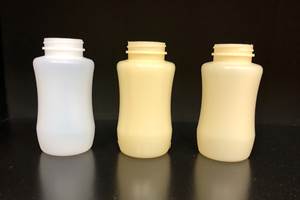Study Deems PHA as Biodegradable Alternative to Single-Use Plastics Like Straws
Applications for polyhydroxyalkanoate (PHA) can include additives, aqueous coatings, fibers, filaments, films, hot-melt adhesives and injection-molded articles.
A pioneer of renewable and sustainable biopolymers for over a decade, with a focus on creating plastic products that are biodegradable and compostable, has gotten a ‘green light’ for its polyhydroxyalkanoate (PHA) material from University of Georgia (UGA) researchers and members of the UGA New Materials Institute.
PHA from Danimer Scientific has been recognized as an eco-friendly alternative to petrochemical plastics, according the study, which was recently published in Environmental Science & Technology. Researchers found that PHA effectively biodegrades in aerobic or anaerobic environments, such as a landfill, waste treatment facility or the ocean.
Danimer’s PHA technology can be found in a broad array of end-use plastic products. Applications for its PHA biopolymers include additives, aqueous coatings, fibers, filaments, films, hot-melt adhesives and injection-molded articles. The company now hold 125 patents in nearly 20 countries for a range of manufacturing processes and biopolymer formulations.
Said Danimer chief marketing officer Scott Tuten, “The results of this study indicate that PHA is a dependable and biodegradable plastic for food packaging and other consumer applications. Many single-use products, such as straws, are under scrutiny or even banned because of their environmental impact at the end of their lifecycle. Our team remains dedicated to helping companies find the quality, sustainable materials that fit their needs. This issue quite literally affects the entire world, so we were grateful for the opportunity to supply UGA with samples of PHA to explore what happens to the material in different environments.”
To determine how PHA biodegrades in a proper waste management scenario, researchers measured the gaseous carbon loss of PHA samples placed in anaerobic sludge after 40 – 60 days of incubation and compared the levels to those of cellulose powder in the same setting. The anaerobic degradation of PHA was not significantly different from that of the cellulose powder. In addition, the methane yields of PHA were found to be similar to food waste, which suggests the material could be effectively processed alongside common organic waste in a landfill.
Said Shunli Wang, Ph.D., postdoctoral research associate in the College of Engineering at UGA, “As governments and businesses consider alternatives to traditional plastics for everything from straws to food packaging, it is important to have a thorough understanding of the impact that different materials will have on various environments. Our study is among the first to comprehensively examine PHA, and results show that it has a relatively fast anaerobic biodegradation rate.”
Researchers also observed the gaseous carbon loss of PHA in seawater, simulating a situation when plastic waste is deposited in an ocean. The study confirmed that if a solid form of PHA were to end up in such an environment it would begin to biodegrade over the course of six months. Polypropylene pellets, a traditional plastic used as the negative control in the experiment, remained intact and unchanged during the same time period.
The final component of the study investigated the microbial diversity of both experiments to identify the bacteria present when PHA degrades. In anaerobic sludge conditions, Cloacamonales and Thermotogales were the dominant bacteria. In aerobic seawater conditions, Gemmatales and Phycisphaerales were the most enriched forms of bacteria. Researchers concluded that future studies would have to include expanded microbial analysis of PHA degradation, which will ultimately help guide the design of more efficient waste management systems.
Read the full paper summarizing the study on the Environmental Science & Technology website.
Related Content
How to Extrusion Blow Mold PHA/PLA Blends
You need to pay attention to the inherent characteristics of biopolymers PHA/PLA materials when setting process parameters to realize better and more consistent outcomes.
Read MoreHow to Optimize Injection Molding of PHA and PHA/PLA Blends
Here are processing guidelines aimed at both getting the PHA resin into the process without degrading it, and reducing residence time at melt temperatures.
Read MoreThe Importance of Mass Balance in Chemical Recycling
Approaches to mass balance can dramatically impact calculations of recycled content.
Read MoreBreaking News From NPE2024
Here is a firsthand report of news in injection molding, extrusion, blow molding and recycling not previously covered.
Read MoreRead Next
Making the Circular Economy a Reality
Driven by brand owner demands and new worldwide legislation, the entire supply chain is working toward the shift to circularity, with some evidence the circular economy has already begun.
Read MoreSee Recyclers Close the Loop on Trade Show Production Scrap at NPE2024
A collaboration between show organizer PLASTICS, recycler CPR and size reduction experts WEIMA and Conair recovered and recycled all production scrap at NPE2024.
Read MoreFor PLASTICS' CEO Seaholm, NPE to Shine Light on Sustainability Successes
With advocacy, communication and sustainability as three main pillars, Seaholm leads a trade association to NPE that ‘is more active today than we have ever been.’
Read More


























